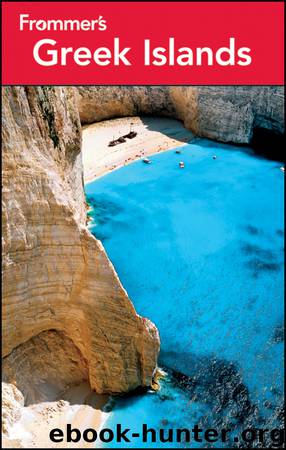Frommer's Greek Islands by John S. Bowman

Author:John S. Bowman
Language: eng
Format: epub
Publisher: John Wiley & Sons, Ltd.
Published: 2012-01-23T16:00:00+00:00
Paros ★★
168km (91 nautical miles) SE of Piraeus
Paros is accurately (but hardly enticingly) known as the “transportation hub” of the Cyclades: Almost all island boats stop here en route to someplace else. As a result, Paros has suffered from the reputation of the place on the way to the place where you’re going. At present, Paros is still cheaper than either Mykonos or Santorini—in fact, some call it the “poor man’s Mykonos”—although rising prices are rapidly making that nickname anachronistic. Comparisons aside, Paros’s good beaches and nightlife have made it a very popular destination in its own right. Because of the absence of any single five-star attraction—there’s no antiquity here to rival Santorini’s ancient Akrotiri and nothing to rival the beauty of Mykonos’s perfect Cycladic architecture—a lot of visitors come here simply to have a good time, windsurfing, sunbathing, and partying.
Still others—not necessarily opposed to having a good time—are drawn back over and over again to Paros because of its other attractions. Admittedly, if you come by ship, your first impression after docking at the main port and capital Parikia will be of the kitsched-up windmill on the quay, travel agents, cafes, and the not terribly enticing fast-food joints lining the harborfront. Where, you’ll wonder, is the town described as “charming”? Take a few steps inland, and you’ll find it. Parikia has an energetic marketplace and the Ekatondapiliani, the 100-doored church designed in the 6th century by the famous architect Isodore of Miletus. Winding streets, the paving stones meticulously marked off with whitewash, lead off from the main square. One street meanders up and up, passing marble fountains and modest houses with elaborate door frames, to the remains of a medieval castle, largely built with chunks pillaged from various local ancient temples.
Somehow, Parikia manages to be both cozy and cosmopolitan. The town has a lively cultural life: The Archilochos Cultural Society stages a winter film festival and hosts a summer music festival (www.archilochos.gr). This is also the home of the Aegean Center for the Fine Arts, which has exhibitions and lectures, and offers several 3-month-long sessions in painting and literature each year (www.aegeancenter.org). Not surprisingly, there are lots of shops and galleries exhibiting and selling work by artists who spend all or part of the year here.
Out on the island, there’s a scattering of appealing villages and two must-see spots: the hillside village of Lefkes, deep in the interior, and the picture-postcard seaside hamlet of Naoussa. Paros also has enough good beaches to keep almost any visitor happy.
Paros is large enough that even if you’re just here for a day, renting a car makes sense. If you’re here in May or June, you can make an around-the-island tour that includes a morning visit to Petaloudes (Valley of the Butterflies), a visit to Lefkes, a stop for a good lunch in Naoussa, a swim at your beach of choice, and a night back in Parikia, where you visit the wonderful Byzantine Ekatondapiliana Cathedral and then n shop and stroll the evening away.
Download
This site does not store any files on its server. We only index and link to content provided by other sites. Please contact the content providers to delete copyright contents if any and email us, we'll remove relevant links or contents immediately.
Spell It Out by David Crystal(35361)
Underground: A Human History of the Worlds Beneath Our Feet by Will Hunt(11266)
A Year in the Merde by Stephen Clarke(4667)
Venice by Jan Morris(2056)
Claridge's: The Cookbook by Nail Martyn & Erickson Meredith(1968)
My Paris Kitchen: Recipes and Stories by Lebovitz David(1895)
A TIME OF GIFTS by Patrick Leigh Fermor(1853)
The Plantagenets by Dan Jones(1622)
Welcome to the Goddamn Ice Cube by Blair Braverman(1607)
Bang Poland: How To Make Love With Polish Girls In Poland by Roosh V(1594)
Top 10 Prague (EYEWITNESS TOP 10 TRAVEL GUIDES) by DK(1571)
From Russia with Lunch by David Smiedt(1554)
The Finnish Way by Katja Pantzar(1539)
The Isle of Mull by Terry Marsh(1522)
A TIME TO KEEP SILENCE by Patrick Leigh Fermor(1501)
Rick Steves London 2018 by Rick Steves & Gene Openshaw(1497)
A Taste of Paris by David Downie(1493)
Merde in Europe by Stephen Clarke(1438)
Insight Guides Experience Tokyo by Insight Guides(1421)
